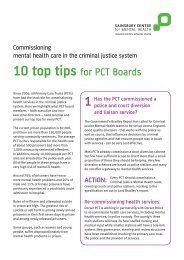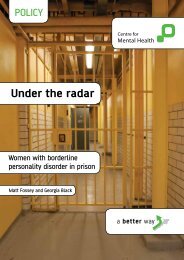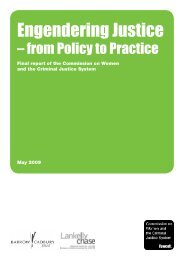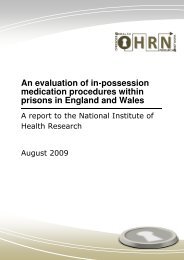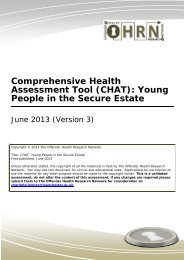Black communities, mental health and the criminal justice system
Black communities, mental health and the criminal justice system
Black communities, mental health and the criminal justice system
You also want an ePaper? Increase the reach of your titles
YUMPU automatically turns print PDFs into web optimized ePapers that Google loves.
Mental <strong>health</strong> <strong>and</strong> crime briefing 20071<strong>Black</strong> <strong>communities</strong>,<strong>mental</strong> <strong>health</strong> <strong>and</strong> <strong>the</strong><strong>criminal</strong> <strong>justice</strong> <strong>system</strong>ContentsIntroduction page 1The <strong>criminal</strong> <strong>justice</strong> <strong>system</strong> page 2The <strong>mental</strong> <strong>health</strong> <strong>system</strong> page 3Government strategy <strong>and</strong> policydevelopment page 5Effecting change page 6Conclusion page 8Nacro believes that responses to <strong>mental</strong>lydisordered offenders should focuson <strong>the</strong>ir care <strong>and</strong> treatment ra<strong>the</strong>r than onpunishment. To help bring about thischange, Nacro campaigns for:more effective working partnershipsbetween agencies<strong>the</strong> development of specialist skills in<strong>the</strong> <strong>criminal</strong> <strong>justice</strong> <strong>system</strong>better information sharing<strong>the</strong> education <strong>and</strong> training of staff sothat <strong>the</strong>y have <strong>the</strong> skills <strong>and</strong>encouragement <strong>the</strong>y need towork with a group who can be difficult<strong>and</strong> unrewarding.Nacro’s Mental Health Unit has beenworking to tackle problems faced by<strong>mental</strong>ly disordered offenders since 1990.We work with government agencies at anational <strong>and</strong> local level to develop moreeffective ways to deal with <strong>mental</strong>lydisordered offenders. We provide a rangeof services: information <strong>and</strong> advice; policydevelopment <strong>and</strong> o<strong>the</strong>r consultancyservices; <strong>and</strong> training. We also run a majorannual conference on <strong>mental</strong> <strong>health</strong> <strong>and</strong>crime.Nacro has a specialist <strong>mental</strong> <strong>health</strong>website which offers information <strong>and</strong>support for practitioners <strong>and</strong> policymakersworking in <strong>the</strong> field of <strong>criminal</strong><strong>justice</strong> <strong>and</strong> <strong>mental</strong> <strong>health</strong>. To find outmore, visit www.nacro<strong>mental</strong><strong>health</strong>.org.ukor contact <strong>the</strong> Mental Health Unit on020 7840 6718, 020 7582 6500 or at<strong>mental</strong><strong>health</strong>@nacro.org.ukwww.nacro<strong>mental</strong><strong>health</strong>.org.ukNacro is a registered charity no.226171IntroductionResearch studies <strong>and</strong> data monitoring have consistently shown that ofall <strong>the</strong> black <strong>and</strong> minority ethnic (BME) groups in Britain, those fromblack <strong>communities</strong> in particular are disproportionately represented inboth <strong>the</strong> <strong>criminal</strong> <strong>justice</strong> <strong>and</strong> <strong>the</strong> <strong>mental</strong> <strong>health</strong> <strong>system</strong>s. 1 This anomalyis compounded by <strong>the</strong> fact that both <strong>system</strong>s seriously disadvantageblack people once within <strong>the</strong>ir remit. This briefing examines <strong>the</strong> extentof <strong>the</strong>se two interconnected problems, <strong>the</strong> underlying causes <strong>and</strong>recent policy <strong>and</strong> strategy developments, before makingrecommendations for change.Despite various policy initiatives in recent years, little progress hasbeen made in tackling this important subject. Home Office statisticshave consistently borne out <strong>the</strong> discrimination experienced byblack people who come into contact with <strong>criminal</strong> <strong>justice</strong> agencies<strong>and</strong> <strong>the</strong> Department of Health has admitted that <strong>the</strong>re is an undueemphasis on coercive models of treatment for black <strong>mental</strong> <strong>health</strong>patients, with organisational requirements often taking precedenceover <strong>the</strong>ir individual needs. 2 Figures show that black people areincreasingly over-represented at each heightened level of securityin <strong>the</strong> psychiatric process from informal to civil detention, <strong>and</strong> <strong>the</strong>nin detention on forensic sections within <strong>the</strong> courts <strong>and</strong> <strong>criminal</strong><strong>justice</strong> <strong>system</strong>. 3 Moreover, <strong>the</strong> fact that <strong>the</strong>re are such highnumbers of black people coming into <strong>criminal</strong> <strong>justice</strong> settings,coupled with <strong>the</strong> discrimination <strong>the</strong>y experience once <strong>the</strong>re, resultin <strong>the</strong> <strong>criminal</strong> <strong>justice</strong> <strong>system</strong> often acting as a gateway to <strong>the</strong><strong>mental</strong> <strong>health</strong> <strong>system</strong> for many black offenders. Indeed recentfigures show that black <strong>communities</strong> are over 40% more likely thanaverage to be referred to <strong>mental</strong> <strong>health</strong> services through <strong>the</strong><strong>criminal</strong> <strong>justice</strong> <strong>system</strong>. 4 With this in mind, this briefing looks inparticular at black <strong>mental</strong>ly disordered offenders who are exposedto both <strong>system</strong>s.Given <strong>the</strong> unequal treatment <strong>and</strong> over-representation that exists inboth <strong>the</strong>se fields, it is crucial that <strong>the</strong> <strong>health</strong>, <strong>criminal</strong> <strong>justice</strong> <strong>and</strong>social care agencies find ways of working with black <strong>communities</strong>to address <strong>the</strong>se problems. In focusing on <strong>the</strong> precise nature of <strong>the</strong>discrimination in <strong>the</strong> <strong>system</strong>, <strong>the</strong> actual pathways which bring blackpeople into <strong>the</strong> <strong>criminal</strong> <strong>justice</strong> <strong>and</strong> <strong>mental</strong> <strong>health</strong> <strong>system</strong>s, <strong>the</strong> typeof treatment <strong>and</strong> care black <strong>mental</strong>ly disordered offenders receiveas well as shortcomings in current policy, this briefing seeks tocreate fur<strong>the</strong>r awareness of this important topic for all thoseworking in <strong>the</strong> <strong>system</strong>, as well as making suggestions forpractitioners in order to improve practice.
2<strong>Black</strong> <strong>communities</strong>, <strong>mental</strong> <strong>health</strong> <strong>and</strong> <strong>the</strong> <strong>criminal</strong> <strong>justice</strong> <strong>system</strong>The <strong>criminal</strong> <strong>justice</strong> <strong>system</strong>Discrimination from <strong>criminal</strong> <strong>justice</strong> agenciesHome Office statistics produced annually undersection 95 of <strong>the</strong> Criminal Justice Act 1991 reveal<strong>the</strong> extent of <strong>the</strong> disproportionate involvement ofblack people with <strong>criminal</strong> <strong>justice</strong> agencies assuspects, defendants <strong>and</strong> prisoners. To fullyappreciate <strong>the</strong> implications of <strong>the</strong> following figures,it should be remembered that of <strong>the</strong> population inEngl<strong>and</strong> <strong>and</strong> Wales, just 1.1% are <strong>Black</strong> Caribbean,0.9% are <strong>Black</strong> African <strong>and</strong> 0.2% are from o<strong>the</strong>r blackgroups. 5 The statistics for 2004-5 6 show that:<strong>Black</strong> people were six times more likely thanwhite people to be stopped <strong>and</strong> searched undersection 1 of <strong>the</strong> Police <strong>and</strong> Criminal Evidence Act1984 compared to Asian people who were twiceas likely as white people to be stopped <strong>and</strong>searched.Searches recorded by police under section 60 of<strong>the</strong> Criminal Justice <strong>and</strong> Public Order Act 1994show that 56% of searches were of white people,24% were of black people, while 17% were ofAsians.Of <strong>the</strong> searches made under Sections 44 (1) <strong>and</strong>44 (2) of <strong>the</strong> Terrorism Act 2000 73% were ofwhite people, 8% were of black people <strong>and</strong> 11%were of Asians, with 5% being carried out onthose of ‘O<strong>the</strong>r’ ethnic origin.Of <strong>the</strong> 1.3 million arrests made for notifiableoffences, 9% of <strong>the</strong>m were black people, 5% Asianpeople <strong>and</strong> 1.5% came from ‘o<strong>the</strong>r’ ethnic groups.<strong>Black</strong> people were more likely than white peopleto be committed at magistrates’ courts to betried by a jury at <strong>the</strong> Crown Court.The proportion of black prisoners who areBritish nationals in <strong>the</strong> prison population is fivetimes higher than for white people.In addition, higher proportions of black people(particularly young people) were likely to bestopped by police, arrested <strong>and</strong> once arrested, lesslikely to be cautioned. Similarly, black people weremore likely to be rem<strong>and</strong>ed in custody, more likelyto plead not guilty <strong>and</strong> where found guilty <strong>the</strong>ywere also more likely to receive longer custodialsentences than <strong>the</strong>ir white contemporaries. 7 Evenbefore coming to trial, an analysis of 13,000 casefiles carried out by <strong>the</strong> Crown Prosecution Servicefound that <strong>the</strong>re were more likely to be objectionsto bail for black males than for white males. 8Figures such as this reveal that black <strong>communities</strong>are over-represented at each stage of <strong>the</strong> <strong>criminal</strong><strong>justice</strong> process from initial contact right throughto sentencing.There are various criminological explanations as to<strong>the</strong> root of this anomaly which include policediscrimination, socio-demographic factors, <strong>and</strong> <strong>the</strong>fact that black people who have previouslycommitted offences are known to <strong>the</strong> police <strong>and</strong> are<strong>the</strong>refore perhaps more easily detected. However,<strong>the</strong> figures cannot just be explained away by <strong>the</strong>notion that black people are more likely to offendthan o<strong>the</strong>r groups. 9 Indeed <strong>the</strong> lifetime offendingrate for black males is in fact significantly lowerthan that for white males. 10GenderGiven that <strong>the</strong>re are higher rates of black women inprisons than men, <strong>and</strong> that <strong>the</strong>re is a higherincidence of black women within psychiatric carethan white women, it is concerning thatexamination of <strong>the</strong> needs of black female <strong>mental</strong>lydisordered offenders is so conspicuously absentfrom research literature <strong>and</strong> policy initiatives. InJune 2004, <strong>the</strong> percentage of foreign nationalwomen in prison made up 25% of <strong>the</strong> female prisonpopulation. Notably, over 50% of female foreignnational prisoners were from Jamaica with over 90%of <strong>the</strong>se receiving custodial sentences for drugimportation. 11 Usually minor players inconsiderably larger operations, <strong>the</strong>se womenundergo <strong>the</strong> trauma of separation from family,children <strong>and</strong> <strong>the</strong>ir homel<strong>and</strong> for what are often verylengthy periods, which is bound to have adebilitating effect on <strong>the</strong>ir <strong>mental</strong> <strong>health</strong>.Immigration <strong>and</strong> asylumIndeed foreign nationals make up one third of allprisoners who are ei<strong>the</strong>r black or minority ethnic. 12The proportion of foreign nationals amongst <strong>the</strong>number of black <strong>mental</strong>ly disordered offenders islikely to increase fur<strong>the</strong>r in future, given <strong>the</strong>introduction of <strong>the</strong> Asylum <strong>and</strong> Immigration Act2004 which has, for <strong>the</strong> first time, made it a<strong>criminal</strong> offence for someone to enter <strong>the</strong> UK whodoes not have a passport or who has destroyedtravel documents or who, once within <strong>the</strong> UK,refuses to co-operate with arrangements for <strong>the</strong>irremoval. Those claiming asylum or refugee statusare likely to have undergone considerable <strong>mental</strong>stress <strong>and</strong> trauma <strong>and</strong>, if this is not effectivelyaddressed, <strong>the</strong> trauma of <strong>the</strong> asylum experiencecould potentially bring to <strong>the</strong> surface any latentdistress <strong>the</strong>y may have experienced previously. 13ResettlementDiscrimination experienced within <strong>the</strong> <strong>criminal</strong><strong>justice</strong> <strong>system</strong> is compounded for many blackpeople by difficulties <strong>the</strong>y encounter followingrelease. A 2005 study by Nacro found that blackprisoners are less likely than <strong>the</strong>ir whiteNacro <strong>mental</strong> <strong>health</strong> <strong>and</strong> crime briefing
4<strong>Black</strong> <strong>communities</strong>, <strong>mental</strong> <strong>health</strong> <strong>and</strong> <strong>the</strong> <strong>criminal</strong> <strong>justice</strong> <strong>system</strong>stereotypical views can often combine with <strong>the</strong>stigma <strong>and</strong> anxiety associated with <strong>mental</strong> illness toundermine <strong>the</strong> ways in which <strong>mental</strong> <strong>health</strong>services respond to black <strong>communities</strong>, affectingdecisions about treatment, medication <strong>and</strong>restriction. NIMHE has noted <strong>the</strong> disproportionatelyhigh rate of schizophrenia diagnosed among black<strong>mental</strong> <strong>health</strong> patients <strong>and</strong> <strong>the</strong> fact that blackpatients generally remain in hospital on a sectionfor longer than <strong>the</strong>ir white contemporaries. 30The fact that <strong>the</strong>re are disproportionate numbers ofblack people coming into <strong>the</strong> <strong>mental</strong> <strong>health</strong> servicesfrom a <strong>criminal</strong> <strong>justice</strong> context means that thisgroup of <strong>mental</strong>ly disordered offenders is oftenviewed by staff as presenting an increased securityrisk compared to that posed by o<strong>the</strong>r groups. Astudy into decision-making in <strong>the</strong> <strong>mental</strong> <strong>health</strong>sectioning process showed professionals made astrong link between black patients <strong>and</strong> a notion ofheightened risk, 31 with <strong>the</strong> result that additionalsafety precautions were frequently seen asnecessary. For example approved social workers(who play a key role in <strong>the</strong> civil sectioning process)are more likely to request a police presence whentaking a black patient to hospital. Prins et al whoseinquiry examined <strong>the</strong> treatment of black <strong>mental</strong>lydisordered offenders found <strong>the</strong>y are also morelikely to be detained in <strong>the</strong> locked wards ofpsychiatric hospitals <strong>and</strong> more likely to betransferred to higher security facilities (<strong>and</strong> forlonger) than white patients. 32NIMHE has also found <strong>the</strong>re is a greater likelihoodof <strong>the</strong> use of coercive treatments for black patientsthan white. 33 Figures for 2005 show that blackpatients are more likely to experience physicalseclusion <strong>and</strong> restraint than o<strong>the</strong>r groups, 34 with<strong>the</strong> most recent figures for 2006 revealing aparticularly high rate of h<strong>and</strong>s-on restraint for thisgroup. 35 Set against this backdrop, it is perhapsunsurprising that black patients are also less likelyto receive benign forms of psycho<strong>the</strong>rapeutictreatment such as psycho<strong>the</strong>rapy <strong>and</strong> counsellingthan <strong>the</strong>ir white counterparts <strong>and</strong> more likely toreceive higher doses of medication, being ‘oftensubjected to heavy doses of drug cocktails whichhas led to deaths in HM prisons <strong>and</strong> specialhospitals’. 36Inquiries such as those into <strong>the</strong> death of Orville<strong>Black</strong>wood have raised concerns about <strong>the</strong> use ofsuch force <strong>and</strong> increased medication as a means ofcontrolling <strong>the</strong> perceived increased security riskassociated with some black patients. Fur<strong>the</strong>rmore,<strong>the</strong> government has openly admitted <strong>the</strong> scale of<strong>the</strong> problem. In February 2004, in a speech inresponse to <strong>the</strong> publication of a report into <strong>the</strong>death of David Bennett, a black patient who died ina medium secure setting after being restrained bystaff, <strong>the</strong> <strong>the</strong>n Secretary of State for Healthconceded <strong>the</strong>re was both direct <strong>and</strong> indirectdiscrimination in services, admitting ‘Behaviours<strong>and</strong> processes that have grown up in <strong>mental</strong> <strong>health</strong>services mean that <strong>the</strong>re is particular inequity in<strong>the</strong> provision of care <strong>and</strong> outcomes for people fromblack <strong>and</strong> ethnic minority groups.’Alternative servicesThe use of inappropriate treatment <strong>and</strong>discriminatory processes within <strong>mental</strong> <strong>health</strong>services is not a recent phenomenon. In <strong>the</strong> lateeighties <strong>and</strong> early nineties, <strong>the</strong>re was increasingdiscussion on providing more appropriatetreatment <strong>and</strong> care for <strong>mental</strong>ly disorderedoffenders in hospitals <strong>and</strong> care settings, asexpounded in <strong>the</strong> Home Office Circular of 1990Provision for Mentally Disordered Offenders. 37 But bythis time, given <strong>the</strong> disproportionately high use ofpsychiatric rem<strong>and</strong>s by magistrates <strong>and</strong> a similartrend in <strong>the</strong> use of transfers from prison to secure<strong>mental</strong> <strong>health</strong> settings, many black <strong>communities</strong><strong>and</strong> <strong>mental</strong> <strong>health</strong> groups had become increasinglyaware of <strong>the</strong> risk of a ‘double jeopardy’ scenariowhere diversion could effectively mean <strong>the</strong> transferfrom one potentially discriminatory <strong>and</strong> damaging<strong>system</strong> to ano<strong>the</strong>r. They realised <strong>the</strong>re mightactually be too much diversion from <strong>criminal</strong><strong>justice</strong> to psychiatry for black people without <strong>the</strong>actual benefit of <strong>the</strong>m <strong>the</strong>n receiving appropriatetreatment <strong>and</strong> care. In response, some black<strong>communities</strong> started developing <strong>the</strong>ir own distinctservices.One such initiative was established in <strong>the</strong> Midl<strong>and</strong>swhich strove to divert African Caribbeans awayfrom psychiatric hospitals to community settings at<strong>the</strong>ir first point of contact with <strong>the</strong> psychiatricservices. 38 Intense support was provided to patientsat a location of <strong>the</strong>ir choosing <strong>and</strong> both users <strong>and</strong>carers were closely involved with <strong>the</strong> process.Admissions to hospital for <strong>the</strong> client group in thislocality were significantly reduced during <strong>the</strong> life ofthis initiative. While this alternative is notnecessarily appropriate for all <strong>mental</strong> <strong>health</strong>patients, it illustrates <strong>the</strong> fact that black<strong>communities</strong> were sufficiently disaffected byexisting provision to implement alternatives, <strong>and</strong>serves as an indicator of <strong>the</strong> additional work thatneeds to be done by <strong>criminal</strong> <strong>justice</strong>, <strong>health</strong> <strong>and</strong>social care agencies to engage black <strong>communities</strong><strong>and</strong> to gain <strong>the</strong>ir trust in <strong>the</strong> mainstream diversion<strong>and</strong> assessment process.Following <strong>the</strong> publication of <strong>the</strong> report into <strong>the</strong>death of David Bennett, 39 <strong>the</strong>re has been increasingdebate about separate services for ethnic minoritiesNacro <strong>mental</strong> <strong>health</strong> <strong>and</strong> crime briefing
5in general psychiatry <strong>and</strong> in some parts of <strong>the</strong> USA,separate in-patient services have been developed. 40It has been argued that separate services mightbetter serve black, as well as o<strong>the</strong>r minority ethnic,patients <strong>and</strong> <strong>the</strong>re might perhaps be increasedemphasis on communicating (between patient <strong>and</strong>practitioner) in a culturally informed way. 41 Thecounter-argument is that <strong>the</strong> creation of separateservices risks <strong>the</strong> development of a divisionbetween those professionals who ‘know’ how totreat <strong>and</strong> care for patients from minority groups,<strong>and</strong> those who ‘do not know’. The creation ofseparate services would appear to be an admissionof failure, not only of <strong>the</strong> current <strong>system</strong>’s ability toprovide adequate support <strong>and</strong> training withinexisting psychiatric services, but also of its abilityto address <strong>the</strong> funda<strong>mental</strong> question of why blackpatients, <strong>and</strong> especially black <strong>mental</strong>ly disorderedoffenders, are treated differently to white people inpsychiatry.Government strategy <strong>and</strong> policydevelopmentThe Reed ReviewIn <strong>the</strong> early 1990s The Review of Health <strong>and</strong> SocialServices for Mentally Disordered Offenders (knownas <strong>the</strong> ‘Reed Review’) by <strong>the</strong> Home Office <strong>and</strong> <strong>the</strong>Department of Health reported its findings. In its1994 volume entitled Race, Gender <strong>and</strong> EqualOpportunities, it recognised that African Caribbeanswere experiencing particular problems (as distinctfrom those encountered by BME <strong>communities</strong> as awhole) <strong>and</strong> that <strong>the</strong>refore <strong>the</strong>ir involvement wascrucial for improving service provision for <strong>the</strong>future, stating:‘It is important that diversion schemes providea service which is appropriate <strong>and</strong> acceptable.This will require <strong>the</strong> involvement of membersof <strong>the</strong> Afro-Caribbean community indeveloping <strong>the</strong> service, as well as <strong>the</strong>involvement of staff who are sensitive to <strong>the</strong>issues of race <strong>and</strong> culture <strong>and</strong> <strong>the</strong> implicationsof socio-economic disadvantage for ethnicminorities.’ 42It is significant that over a decade after <strong>the</strong> ReedReview, <strong>the</strong> over-representation <strong>and</strong> discriminationexperienced by black people in <strong>the</strong> <strong>mental</strong> <strong>health</strong><strong>system</strong> has still not been effectively addressed.However, <strong>the</strong>re have been some strategy <strong>and</strong> policydevelopments in this area in <strong>the</strong> meantime.‘Culturally capable’ servicesIn 2003 NIMHE set out in <strong>the</strong> progressive document,Inside Outside, its strategic objectives for improving<strong>mental</strong> <strong>health</strong> services for BME <strong>communities</strong> inEngl<strong>and</strong>. 43 These included <strong>the</strong> need to:reduce <strong>and</strong> eliminate ethnic inequalities in<strong>mental</strong> <strong>health</strong> service experience <strong>and</strong> outcomesdevelop a <strong>mental</strong> <strong>health</strong> workforce that iscapable of delivering effective <strong>mental</strong> <strong>health</strong>services to a multi-cultural populationenhance <strong>and</strong> build on capacity within BME<strong>communities</strong> <strong>and</strong> within <strong>the</strong> voluntary sector fordealing with <strong>mental</strong> ill <strong>health</strong>Inside Outside discussed strategic tools that wouldhelp realise <strong>the</strong>se objectives <strong>and</strong> advancedproposals to expedite <strong>the</strong> development of so-called‘culturally capable services’ which included settingnational st<strong>and</strong>ards to improve access, experience<strong>and</strong> outcomes for BME users <strong>and</strong> making research<strong>and</strong> development more culturally relevant.However, <strong>the</strong>re was little focus on ei<strong>the</strong>r forensicissues or on <strong>the</strong> role of <strong>the</strong> <strong>criminal</strong> <strong>justice</strong> <strong>system</strong><strong>and</strong> offending in <strong>mental</strong> <strong>health</strong>.The Bennett InquiryThe inquiry into <strong>the</strong> death of David Bennett in 2003made a series of recommendations which also heldimplications for <strong>the</strong> treatment <strong>and</strong> care of black, aswell as minority ethnic, individuals held in securesettings. 44 These included <strong>the</strong> following:All <strong>mental</strong> <strong>health</strong> services should have a writtenpolicy dealing with racist abuse <strong>and</strong> records ofsuch incidents should be kept.The <strong>mental</strong> <strong>health</strong> workforce should beethnically diverse <strong>and</strong>, where appropriate, stepsshould be taken to recruit, retain <strong>and</strong> promotestaff from BME <strong>communities</strong>.A national staff training programme in restraint<strong>and</strong> control methods should be instituted asquickly as possible – <strong>and</strong> certainly within twelvemonths.No patient should be restrained in a proneposition for more than three minutes. Allpsychiatric units should keep records of <strong>the</strong> useof control <strong>and</strong> restraint of all patients. Thesereports should be audited by <strong>the</strong> Department ofHealth.The recommendations above were accepted withoutamendment by <strong>the</strong> Department of Health, with <strong>the</strong>exception of <strong>the</strong> final one. (The wording preferredby <strong>the</strong> government in its response to <strong>the</strong> fourthrecommendation was that any physical interventionshould be used only as a last resort, in <strong>the</strong> safestway possible, <strong>and</strong> for <strong>the</strong> shortest period of timethat is necessary for patient <strong>and</strong> staff safety.)
6<strong>Black</strong> <strong>communities</strong>, <strong>mental</strong> <strong>health</strong> <strong>and</strong> <strong>the</strong> <strong>criminal</strong> <strong>justice</strong> <strong>system</strong>These recommendations <strong>and</strong> o<strong>the</strong>rs, by virtue of<strong>the</strong> fact that <strong>the</strong>y cut across <strong>mental</strong> <strong>health</strong> care ingeneral, will consequently impact on black peoplewith <strong>mental</strong> <strong>health</strong> problems who are also involvedin <strong>the</strong> <strong>criminal</strong> <strong>justice</strong> <strong>system</strong>. But it remains <strong>the</strong>case that provision for black <strong>mental</strong>ly disorderedoffenders in particular, has received little specificfocus from <strong>the</strong> Home Office or Department ofHealth since <strong>the</strong> commission of <strong>the</strong> Reed Reviewover a decade ago.Working toge<strong>the</strong>rDelivering Race Equality in Mental Health Care(DRE), produced by <strong>the</strong> Department of Health in2005, 45 proved a useful document as it recognisedthat in <strong>the</strong> debate about black over-representationin <strong>mental</strong> <strong>health</strong>, a shift had generally taken placeaway from notions of deviancy, dangerousness <strong>and</strong>genetics <strong>and</strong> towards socio-cultural explanations inline with <strong>the</strong> concept of ‘institutional racism’. 46Certain authors, such as Fern<strong>and</strong>o 47 had beenespousing similar concepts for some years.However <strong>the</strong> shift was important, as it broadlymirrored <strong>the</strong> parallel development in <strong>the</strong> field ofrace <strong>and</strong> <strong>criminal</strong> <strong>justice</strong> where, in <strong>the</strong> light of <strong>the</strong>MacPherson Inquiry Report into <strong>the</strong> death ofStephen Lawrence, <strong>criminal</strong> <strong>justice</strong> agencies(principally <strong>the</strong> police) began to accept <strong>the</strong> concept<strong>and</strong> existence of institutional racism <strong>and</strong> to modifypolicies <strong>and</strong> procedures accordingly.Importantly, DRE set out a national strategy forgreater community engagement <strong>and</strong> partnershipwork between mainstream <strong>and</strong> statutory services on<strong>the</strong> one h<strong>and</strong>, <strong>and</strong> black <strong>and</strong> o<strong>the</strong>r minority ethniccommunity <strong>and</strong> <strong>mental</strong> <strong>health</strong> groups on <strong>the</strong> o<strong>the</strong>r,in recognition of <strong>the</strong> key role <strong>the</strong> latter have to playin <strong>the</strong> development <strong>and</strong> provision of services. Itresolved to recruit 500 community developmentworkers nationally who would be expected to workat a senior level <strong>and</strong> alongside <strong>the</strong> regional RaceEquality Leads within <strong>health</strong> <strong>and</strong> social care,focusing on improving commissioning, access,experience <strong>and</strong> outcomes for all ethnic minority<strong>communities</strong>. It also recognised <strong>the</strong> need forstatutory services to be involved in:forming partnerships with faith <strong>communities</strong>ensuring that representatives of BME voluntarysector partners are of comparable seniority tostatutory sector representativesfunding or section 64 (Department of Health)grantspractically supporting <strong>the</strong> capacity of BMEgroups to become involved in <strong>the</strong> planning,designing <strong>and</strong> delivery of servicesputting in place mechanisms to facilitate mutuallearning between BME-delivered services <strong>and</strong>mainstream servicesThis is a useful framework for engagement <strong>and</strong> hasechoes of a recommendation from <strong>the</strong> Reed Reviewwhich stated that: ‘…all agencies involved with<strong>mental</strong>ly disordered offenders should establishstrong pro-active equal opportunities policiesrelating to race <strong>and</strong> culture which should bereflected in staff training <strong>and</strong> allow for consultationwith representatives of ethnic minority groups in<strong>the</strong> planning, development <strong>and</strong> monitoring ofservices.’ 48 However, while community engagementis central to <strong>the</strong> arguments within DRE, it should benoted that it did not specifically relate <strong>the</strong>arguments <strong>and</strong> recommendations to <strong>mental</strong>lydisordered offenders from black or minority ethnicgroups. When developing ways of working inpartnership to provide services <strong>and</strong> engaging withservice user groups, it is important that blackcommunity groups are not perceived as beingrelevant solely to issues seen as tangible ‘black’issues, <strong>and</strong> that <strong>the</strong>re is also an awareness of race<strong>and</strong> faith considerations.New initiativesThere are some new initiatives underway though toimprove services for <strong>mental</strong>ly disordered offenders.Health <strong>and</strong> Offender Partnerships (HOPs) is apartnership directorate between <strong>the</strong> Home Office(NOMS) <strong>and</strong> <strong>the</strong> Department of Health (Care ServicesDirectorate). HOPs includes <strong>the</strong> Home Office MentalHealth Unit <strong>and</strong> Prison Health at <strong>the</strong> Department ofHealth <strong>and</strong> its core initiative is to tackle <strong>health</strong>inequality <strong>and</strong> reduce offending. Currently, it isdeveloping an offender <strong>health</strong> strategy whichfocuses on all parts of <strong>the</strong> <strong>criminal</strong> <strong>justice</strong> <strong>system</strong>,including <strong>the</strong> large body of offenders beingsupervised in <strong>the</strong> community. However, <strong>the</strong> key testin respect of approaches to <strong>mental</strong>ly disorderedoffenders from <strong>the</strong> black community will bewhe<strong>the</strong>r this development will be able to marrysome of <strong>the</strong> innovative ideas from initiatives suchas DRE with <strong>the</strong> more mainstream thrust of HOPs.commissioning BME specialist services on <strong>the</strong>basis of needs assessment <strong>and</strong> overall servicestrategyidentifying BME voluntary sector groups thatmight be potential c<strong>and</strong>idates for TreasuryEffecting changeBringing about change in <strong>the</strong> future will require aconcerted <strong>and</strong> <strong>system</strong>atic approach: <strong>the</strong>re needs tobe a new drive towards working in partnership withNacro <strong>mental</strong> <strong>health</strong> <strong>and</strong> crime briefing
7black groups, <strong>and</strong> an improved focus on <strong>the</strong>development <strong>and</strong> delivery of services. To achievethis, reform needs to focus on <strong>the</strong> following threeareasChanges in monitoring <strong>and</strong> funding procedures.Increasing staff <strong>and</strong> practitioner awareness of<strong>the</strong> needs of <strong>the</strong> black community <strong>and</strong> a renewedcommitment to dealing with <strong>the</strong>ir needseffectively <strong>and</strong> fairly.Successfully engaging <strong>and</strong> fully involving black<strong>communities</strong> in <strong>the</strong> reform of services.Monitoring <strong>and</strong> funding proceduresThe precursor for any initiative developed,however, is <strong>the</strong> need for robust ethnic monitoringdata across both <strong>system</strong>s. To improve bothmonitoring <strong>and</strong> funding procedures, <strong>the</strong> followingmeasures need to be implemented:All <strong>criminal</strong> <strong>justice</strong> <strong>and</strong> <strong>mental</strong> <strong>health</strong> agenciesshould adhere to <strong>the</strong> ethnic category dataguidance produced by <strong>the</strong> Department of Health<strong>and</strong> statistics collected by <strong>the</strong> Home Office on<strong>mental</strong>ly disordered offenders should be brokendown by ethnicity.Criminal <strong>justice</strong> <strong>mental</strong> <strong>health</strong> liaison schemes(<strong>and</strong> in particular court-based schemes) shouldhave rigorous, effective ethnic monitoringprocedures in place which collect useful <strong>and</strong>comparable data.The data, once collected, must be properlyanalysed <strong>and</strong> made available to funders, schemesteering groups <strong>and</strong> strategic multi-agencyforums (where <strong>the</strong>y are in place) who must <strong>the</strong>nbe prepared to act on <strong>the</strong> data provided in orderto improve services for black <strong>communities</strong>.Resources <strong>and</strong> funding should be made availableboth from <strong>the</strong> centre <strong>and</strong> locally, so as tominimise barriers to <strong>the</strong> implementation ofrecommendations made by <strong>mental</strong> <strong>health</strong> <strong>and</strong>black community organisations, <strong>and</strong> o<strong>the</strong>rrelevant bodies.Increased awareness of staff <strong>and</strong> practitionersStaff working with black <strong>mental</strong>ly disorderedoffenders have a crucial part to play in improvingservices. Making good practice guidance availableto staff <strong>and</strong> practitioners in this area would greatlyassist this process. Resettlement work <strong>and</strong> workwith black female <strong>mental</strong>ly disordered offenders aretwo areas where improving practice is particularlyimportant.It is vital that resettlement staff work alongsidefamilies <strong>and</strong> community <strong>and</strong> faith groups so thatsuccessful programmes can be developed. Inaddition, it is imperative that staff build stronglinks with black <strong>mental</strong> <strong>health</strong> <strong>and</strong> communitygroups <strong>and</strong> service user groups, so that staff cannotify <strong>the</strong>m of any <strong>mental</strong> <strong>health</strong> problems orfeelings of exclusion due to ethnicity which blackex-offenders might be experiencing.Practitioners need to be aware too of <strong>the</strong> manyprejudices that female black <strong>mental</strong>ly disorderedoffenders face in particular. In light of this, <strong>the</strong>yneed to take into account <strong>the</strong> following issues in<strong>the</strong>ir practice:The resettlement needs of black women.The planning <strong>and</strong> development of communityprovision for black women.The needs of women asylum seekers <strong>and</strong> thoseseeking refugee status.Engaging black women’s groups when building<strong>and</strong> sustaining partnerships with voluntarysector groups.The trauma caused by separation from <strong>the</strong>irfamilies <strong>and</strong> children for black women detainedin <strong>the</strong> <strong>criminal</strong> <strong>justice</strong> <strong>and</strong> <strong>mental</strong> <strong>health</strong><strong>system</strong>s, especially for foreign national womenwhose families <strong>and</strong> children may live in adifferent country.Working in partnership with <strong>the</strong> black communityTo achieve better outcomes for black <strong>mental</strong>lydisordered offenders, primary care trusts <strong>and</strong><strong>mental</strong> <strong>health</strong> trusts should consider taking <strong>the</strong>following steps:Involving black community <strong>and</strong> <strong>mental</strong> <strong>health</strong>groups in <strong>the</strong> development <strong>and</strong> running ofcourt-based diversion, liaison or assessmentschemes.Ensuring local <strong>mental</strong>ly disordered offenders’steering groups include representation from arelevant local black <strong>mental</strong> <strong>health</strong> or communitygroup, in order to include a black perspective on<strong>the</strong> development of strategic plans for servicesfor <strong>mental</strong>ly disordered offenders.Involving local black community <strong>and</strong> <strong>mental</strong><strong>health</strong> group representation in Section 136 MHAmonitoring groups.Encouraging <strong>the</strong> creation of an effective <strong>and</strong>authoritative association of black service users.Involving black <strong>health</strong> groups in a wide range ofissues ra<strong>the</strong>r than solely with what areconsidered to be ‘black’ issues.
8<strong>Black</strong> <strong>communities</strong>, <strong>mental</strong> <strong>health</strong> <strong>and</strong> <strong>the</strong> <strong>criminal</strong> <strong>justice</strong> <strong>system</strong>ConclusionThere is clearly a continued need for governmentdepartments <strong>and</strong> <strong>criminal</strong> <strong>justice</strong> <strong>and</strong> <strong>mental</strong> <strong>health</strong>agencies to tackle <strong>the</strong> many difficult issues thatpersist in <strong>the</strong> relationship between black<strong>communities</strong>, <strong>criminal</strong> <strong>justice</strong> <strong>and</strong> psychiatry. Thekey strategy documents of recent years have addedlittle of substance to <strong>the</strong> material produced in <strong>the</strong>last two decades <strong>and</strong> many have avoided <strong>the</strong> focusof black <strong>mental</strong>ly disordered offenders altoge<strong>the</strong>r.Not only is progress needed in <strong>the</strong> key areasmentioned above (eg rigorous ethnic monitoring incourt diversion <strong>and</strong> <strong>criminal</strong> <strong>justice</strong> liaisonschemes; greater black representation on scheme<strong>and</strong> section 136 steering groups; central monitoringof <strong>the</strong> ethnicity of black <strong>mental</strong>ly disorderedoffenders; improved service delivery <strong>and</strong> bettercommunity engagement) but <strong>the</strong>re is also a need fora concerted <strong>and</strong> inclusive strategy towards black<strong>and</strong> minority ethnic <strong>mental</strong>ly disordered offenderswhich cohesively tackles <strong>the</strong> particular problems<strong>the</strong>y experience in areas such as immigration,asylum <strong>and</strong> resettlement. Given that <strong>the</strong> <strong>criminal</strong><strong>justice</strong> <strong>system</strong> can act as a gateway to <strong>the</strong> <strong>mental</strong><strong>health</strong> <strong>system</strong>, <strong>the</strong> need for comprehensive actionthat reforms both <strong>system</strong>s is all <strong>the</strong> more pressing.The danger, if this does not happen, is that policymakersin this field will find <strong>the</strong>mselves perpetuallyaddressing <strong>the</strong> symptoms ra<strong>the</strong>r than <strong>the</strong> causes of<strong>the</strong>se inequalities.References1 Fern<strong>and</strong>o S (1991) Mental Health, Race <strong>and</strong> Culture London:Macmillan/MIND Publications2 Department of Health (2003) Inside Outside: Improving MentalHealth Services for <strong>Black</strong> <strong>and</strong> Minority Ethnic Communities inEngl<strong>and</strong> London: Department of Health3 Cope R (1989) ‘The Compulsory Detention of Afro-Caribbeansunder <strong>the</strong> Mental Health Act’ New Community 15 (3) pp. 343-3564 Healthcare Commission (2007) Results of <strong>the</strong> 2006 NationalCensus of Inpatients in Mental Health <strong>and</strong> Learning DisabilityServices in Engl<strong>and</strong> <strong>and</strong> Wales London: Commission forHealthcare, Audit <strong>and</strong> Inspection5 Office for National Statistics (2003) Census 2001: Ethnicity <strong>and</strong>religion in Engl<strong>and</strong> <strong>and</strong> Wales London: Office for National Statistics6 Reza B <strong>and</strong> Magill C (2006) Race <strong>and</strong> <strong>the</strong> Criminal Justice System:An overview to <strong>the</strong> complete statistics 2004-2005 London: CriminalJustice System (Race Unit)7 Fitzgerald M (1993) ‘Ethnic Minorities <strong>and</strong> <strong>the</strong> Criminal JusticeSystem’ Royal Commission on Criminal Justice Research Study 20London: HMSO8 John G (2003) Race for Justice: A review of CPS decision makingfor possible racial bias at each stage of <strong>the</strong> prosecution processLondon: Crown Prosecution Service9 Sharp C <strong>and</strong> Budd T (2005) Minority Ethnic Groups <strong>and</strong> Crime:Findings from <strong>the</strong> Offending, Crime <strong>and</strong> Justice Survey 2003.Home Office online report 33/0510 Reza B <strong>and</strong> Magill C (2006) Race <strong>and</strong> <strong>the</strong> Criminal Justice System11 HM Inspectorate of Prisons (2005) Women in Prison London: HomeOffice12 Reza B <strong>and</strong> Magill C (2006) Race <strong>and</strong> <strong>the</strong> Criminal Justice System13 Baluchi B (1999) Beyond Urgent: Towards a strategy for refugee<strong>health</strong> London: Kimia Institute14 Nacro (2005) Integrated Resettlement: Putting <strong>the</strong> pieces toge<strong>the</strong>rLondon: Nacro15 ibid16 The Housing Corporation (1998) <strong>Black</strong> <strong>and</strong> Minority EthnicHousing Policy London: The Housing Corporation17 Healthcare Commission (2005) Count Me In: Results of a nationalcensus of inpatients in <strong>mental</strong> <strong>health</strong> hospitals <strong>and</strong> facilities inEngl<strong>and</strong> <strong>and</strong> Wales London: Commission for Healthcare, Audit <strong>and</strong>Inspection18 Office for National Statistics (2003) Census 200119 Healthcare Commission (2007) Results of <strong>the</strong> 2006 NationalCensus of Inpatients20 Department of Health (2003) Delivering Race Equality – AFramework for Action: Mental <strong>health</strong> services consultationdocument London: Department of Health21 Nacro (1990) <strong>Black</strong> People, Mental Health <strong>and</strong> <strong>the</strong> Courts: Anexploratory study into <strong>the</strong> psychiatric rem<strong>and</strong> process as it affectsblack defendants at magistrates’ courts London: Nacro22 Browne D (1997) <strong>Black</strong> People <strong>and</strong> Sectioning: The blackexperience of detention under <strong>the</strong> civil sections of <strong>the</strong> MentalHealth Act London: Little Rock Publishing23 Smaje C (1995) Health, Race <strong>and</strong> Ethnicity: Making sense of <strong>the</strong>evidence London: King’s Fund Institute24 Healthcare Commission (2005) Count Me In: Results of a nationalcensus of inpatients25 Healthcare Commission (2007) Results of <strong>the</strong> 2006 NationalCensus of Inpatients26 Healthcare Commission (2005) Count Me In: Results of a nationalcensus of inpatients27 Nacro (1990) <strong>Black</strong> People, Mental Health <strong>and</strong> <strong>the</strong> Courts28 Prins H, <strong>Black</strong>er-Holst T, Francis E <strong>and</strong> Keitch I (1993) Report of <strong>the</strong>Committee of Inquiry into <strong>the</strong> Death in Broadmoor Hospital ofOrville <strong>Black</strong>wood <strong>and</strong> a Review of <strong>the</strong> Deaths of Two O<strong>the</strong>r Afro-Caribbean Patients. Big, <strong>Black</strong> <strong>and</strong> Dangerous. London: SpecialHospitals Service Authority29 Cope R <strong>and</strong> Ndegwa D (1990) ‘Ethnic differences in admissions toa regional secure unit’ Journal of Forensic Psychiatry 1(3) pp. 365-37830 Department of Health (2003) Inside Outside31 Browne D (1997) <strong>Black</strong> People <strong>and</strong> Sectioning32 Prins H et al (1993) Report of <strong>the</strong> Committee of Inquiry into <strong>the</strong>Death in Broadmoor Hospital33 Department of Health (2003) Inside Outside34 Healthcare Commission (2005) Count Me In: Results of a nationalcensus of inpatients35 Healthcare Commission (2007) Results of <strong>the</strong> 2006 NationalCensus of Inpatients36 Prins H et al (1993) Report of <strong>the</strong> Committee of Inquiry into <strong>the</strong>Death in Broadmoor Hospital37 Home Office (1990) Provision for Mentally Disordered OffendersCircular 66/90 London: HMSO38 Francis E, David J, Johnson N <strong>and</strong> Sashidharan S P (1989) ‘<strong>Black</strong>People <strong>and</strong> Psychiatry in <strong>the</strong> UK’ Psychiatric Bulletin 13, pp. 482-48539 Norfolk, Suffolk <strong>and</strong> Cambridgeshire Health Authority (2003)Independent Inquiry into <strong>the</strong> Death of David Bennett Cambridge:Cambridgeshire Health Authority40 Bhui K <strong>and</strong> Sashidharan S P (2003) ‘Should <strong>the</strong>re be separatepsychiatric services for ethnic minority groups?’ British Journal ofPsychiatry, 182, pp. 10-1241 Lyall M. (2005) ‘Should <strong>the</strong>re be separate forensic psychiatryservices for ethnic minority patients?’ Journal of ForensicPsychiatry <strong>and</strong> Psychology 16 (2) pp. 370-37942 Reed J (1994) Vol 6: Race, Gender <strong>and</strong> Equal Opportunities (Reviewof Health <strong>and</strong> Social Services for Mentally Disordered Offenders<strong>and</strong> O<strong>the</strong>rs Requiring Similar Services) London: HMSO43 Department of Health (2003) Inside Outside44 Norfolk, Suffolk <strong>and</strong> Cambridgeshire Health Authority (2003)Independent Inquiry into <strong>the</strong> Death of David Bennett45 Department of Health (2005) Delivering Race Equality in MentalHealth Care: An action plan for reform inside <strong>and</strong> outside services(including <strong>the</strong> Government’s response to <strong>the</strong> independent inquiryinto <strong>the</strong> death of David Bennett) London: Department of Health46 Vige M ‘Race <strong>and</strong> Mental Health Treatment’ Criminal JusticeMonthly 61 pp. 28-3147 Fern<strong>and</strong>o S (1991) Mental Health, Race <strong>and</strong> Culture48 Reed J (1994) Vol 6: Race, Gender <strong>and</strong> Equal OpportunitiesNacro <strong>mental</strong> <strong>health</strong> <strong>and</strong> crime briefing







